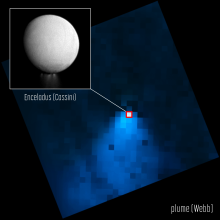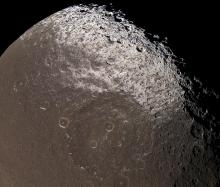Listen to today's episode of StarDate on the web the same day it airs in high-quality streaming audio without any extra ads or announcements. Choose a $8 one-month pass, or listen every day for a year for just $30.
You are here
Last Visit
The Cassini spacecraft has been orbiting Saturn for almost 13 years. During that time, it’s made many visits to the giant planet’s moons. It’s paid special attention to the biggest moon, Titan, passing less than a thousand miles from it dozens of times. And on Saturday, it’ll make one final pass by the big moon — its final close encounter with any of Saturn’s moons.
Titan is veiled by smog — an orange haze that makes it impossible to see the surface. But Cassini has viewed the moon at wavelengths that are invisible to the eye. Those wavelengths pass through the haze, allowing Cassini to study the surface in detail.
Among other things, those observations have revealed sand dunes that can be hundreds of miles long, and lakes and seas that are filled with liquid hydrocarbons. The largest is bigger than Lake Superior. Occasional rains may fill rivers, which then flow into the lakes and seas.
Cassini has also given us hints of even more liquid far below Titan’s surface — an ocean of water mixed with ammonia. It could be many miles thick, and contain far more water than in all of Earth’s oceans.
Cassini will fly about 600 miles above Titan on Saturday, giving scientists a farewell look at the intriguing moon. As a bonus, Titan’s gravity will reshape Cassini’s orbit, placing it on a course that’ll carry the craft between Saturn and the inner edge of its rings — beginning the final phase of its lifetime of discovery. More about that tomorrow.
Script by Damond Benningfield





